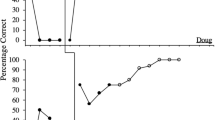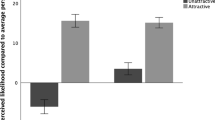Abstract
When experiencing aggression from group members, chimpanzees commonly produce screams. These agonistic screams are graded signals and vary acoustically as a function of the severity of aggression the caller is facing. We conducted a series of field playback experiments with a community of wild chimpanzees in the Budongo Forest, Uganda, to determine whether individuals could meaningfully distinguish between screams given in different agonistic contexts. We compared six subjects’ responses to screams given in response to severe and mild aggression. Subjects consistently discriminated between the two scream types. To address the possibility that the response differences were driven directly by the screams’ peripheral acoustic features, rather than any attached social meaning, we also tested the subjects’ responses to tantrum screams. These screams are given by individuals that experienced social frustration, but no physical threat, yet acoustically they are very similar to screams of victims of severe aggression. We found chimpanzees looked longer at severe victim screams than either mild victim screams or tantrum screams. Our results indicate that chimpanzees attend to the informational content of screams and are able to distinguish between different scream variants, which form part of a graded continuum.


Similar content being viewed by others
References
Bergman TJ, Beehner JC, Cheney DL, Seyfarth RM (2003) Hierarchical classification by rank and kinship in baboons. Science 302:1234–1236
Charlton B, Reby D, McComb K (2007) Female red deer prefer the roars of larger males. Biol Lett 3(4):382–385
Cheney DL, Seyfarth RM (1980) Vocal recognition in free ranging vervet monkeys. Anim Behav 28(2):362–367
Cheney DL, Seyfarth RM (2007) Baboon metaphysics: the evolution of a social mind. University of Chicago Press, Chicago
Cheney DL, Seyfarth RM, Silk JB (1995) The responses of female baboons (Papio cynocephalus ursinus) to anomalous social interactions: evidence for causal reasoning? J Comp Psychol 109:134–141
Eggeling WJ (1947) Observations on the ecology of Budongo rain forest, Uganda. J Ecol 34:20–87
Fawcett K, Muhumuza G (2000) Death of a wild chimpanzee community member: possible outcome of intense sexual competition. Am J Primatol 51:243–247
Fichtel C, Hammerschmidt K (2003) Responses of squirrel monkeys to their experimentally modified mobbing calls. J Acoust Soc Am 113:2927–2932
Fischer J (1998) Barbary macaques categorize shrill barks into two call types. Anim Behav 55:799–807
Fischer J (2004) Emergence of individual recognition in young macaques. Anim Behav 67:655–661
Fugate JMB, Gouzoules H, Nygaard LC (2008) Recognition of rhesus macaque (Macaca mulatta) noisy screams: evidence from conspecifics and human listeners. Am J Primatol 70:594–604
Gouzoules S, Gouzoules H, Marler P (1984) Rhesus monkey (Macaca mulatta) screams: representational signalling in the recruitment of agonistic aid. Anim Behav 32:182–193
Gouzoules H, Gouzoules S, Marler P (1986) Vocal communication: a vehicle for the study of social relationships. In: Rawlings RG, Kessler MJ (eds) The Cayo Santiago macaques. SUNY Press, Albany, pp 111–129
Herbinger I (2004) Inter-group aggression in wild West African chimpanzees (Pan troglodytes verus): mechanisms and functions. PhD thesis, University of Leipzig, Germany
Kojima S, Izumi A, Ceugniet M (2003) Identification of vocalisers by pant hoots, pant grunts and screams in a chimpanzee. Primates 44:225–230
Liberman AM, Harris KS, Hoffman HS, Griffith BC (1957) The discrimination of speech sounds within and across phoneme boundaries. J Exp Psychol 54:358–368
Mundry R, Fischer J (1998) Use of statistical programs for nonparametric tests of small samples often leads to incorrect p values: examples from animal behaviour. Anim Behav 56:256–259
Owren MJ, Rendall D (1997) An affect-conditioning model of nonhuman primate vocal signalling. In: Owings DH et al (eds) Perspectives in ethology. Plenum Press, New York, pp 299–346
Owren MJ, Rendall D (2003) Salience of caller identity in rhesus monkey (Macaca mulatta) coos and screams: perceptual experiments with humans (Homo sapiens) listeners. J Comp Psychol 117:380–390
Pfefferle D, Heistermann M, Hodges K, Fischer J (2008) Male Barbary macaques eavesdrop on mating outcome: a playback study. Anim Behav 75:1885–1891
Rendall D, Rodman PS, Emond RE (1996) Vocal recognition of individuals and kin in free-ranging rhesus monkeys. Anim Behav 51:1007–1015
Reynolds V (2005) The chimpanzees of Budongo Forest: ecology, behaviour and conservation. Oxford University Press, Oxford
Seyfarth RM, Cheney DL (2003) Signalers and receivers in animal communication. Annu Rev Psychol 54:145–173
Seyfarth RM, Cheney DL, Marler P (1980) Vervet monkey alarm calls: semantic communication in a free-ranging primate. Anim Behav 28(4):1070–1094
Silk JB, Brosnan SF, Vonk J, Henrich J, Povinelli DJ, Richardson AS, Lambeth SP, Mascaro J, Schapiro SJ (2005) Chimpanzees are indifferent to the welfare of unrelated group members. Nature 437(7063):1357–1359
Slocombe KE, Zuberbühler K (2005a) Functionally referential communication in a chimpanzee. Curr Biol 15(19):1779–1784
Slocombe KE, Zuberbühler K (2005b) Agonistic screams in wild chimpanzees vary as a function of social role. J Comp Psychol 119(1):67–77
Slocombe KE, Zuberbühler K (2007) Chimpanzees modify recruitment screams as a function of audience composition. Proc Natl Acad Sci 104:17228–17233
Tomasello M (2008) Origins of human communication. MIT Press, Cambridge
Townsend SW, Slocombe KE, Emery-Thompson M, Zuberbühler K (2007) Female-led infanticide in wild chimpanzees. Curr Biol 17(10):355–356
Wilson ML, Hauser MD, Wrangham RW (2001) Does participation in intergroup conflict depend on numerical assessment, range location, or rank for wild chimpanzees? Anim Behav 61(6):1203–1216
Wittig RM, Crockford C, Seyfarth RM, Cheney DL (2007a) Vocal alliances in chacma baboons, Papio hamadryas ursinus. Behav Ecol Sociobiol 61:899–909
Wittig RM, Crockford C, Wikberg E, Seyfarth RM, Cheney DL (2007b) Kin-mediated reconciliation substitutes for direct reconciliation in female baboons. Proc R Soc B 274:1109–1115
Zuberbühler K (2003) Referential signaling in non-human primates: cognitive precursors and limitations for the evolution of language. Adv Study Behav 33:265–307
Acknowledgments
We thank the staff of the Budongo Conservation Field Station (BCFS), particularly field assistants Monday Gideon, Afeku Alfred, Jackson Okuti, Steven Amati, Sam Adieu, Geresomu Muhamuza and James Kakura for invaluable contributions to running these experiments. We thank Zanna Clay, Tanja Kaller, Anne Marijke Schel and Marion Laporte for assistance with conducting these experiments. We thank Robert Seyfarth, Richard Byrne, Lucy Bates, Drew Rendall and Sarah Papworth for comments on the manuscript. We are grateful to UWA, UNSCT and the Presidents Office for permission to live and work in Uganda. This work complies with the research regulations, ethical guidelines, and laws of Uganda and the guidelines of the University of St Andrews. We thank the Royal Zoological Society of Scotland for providing core funding to BCFS. This research was funded by the BBSRC.
Author information
Authors and Affiliations
Corresponding author
Rights and permissions
About this article
Cite this article
Slocombe, K.E., Townsend, S.W. & Zuberbühler, K. Wild chimpanzees (Pan troglodytes schweinfurthii) distinguish between different scream types: evidence from a playback study. Anim Cogn 12, 441–449 (2009). https://doi.org/10.1007/s10071-008-0204-x
Received:
Revised:
Accepted:
Published:
Issue Date:
DOI: https://doi.org/10.1007/s10071-008-0204-x




